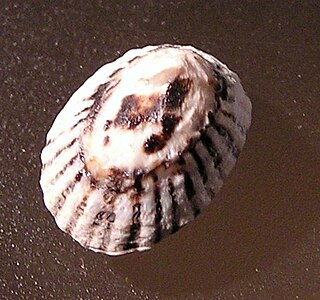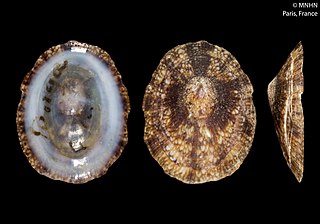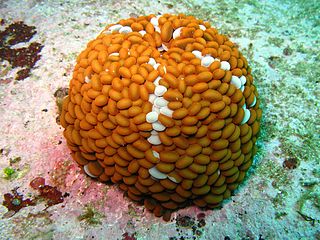
A tunicate is a marine invertebrate animal, a member of the subphylum Tunicata. It is part of the Chordata, a phylum which includes all animals with dorsal nerve cords and notochords. The subphylum was at one time called Urochordata, and the term urochordates is still sometimes used for these animals. They are the only chordates that have lost their myomeric segmentation, with the possible exception of the 'seriation of the gill slits'.

Ascidiacea, commonly known as the ascidians, tunicates, and sea squirts, is a polyphyletic class in the subphylum Tunicata of sac-like marine invertebrate filter feeders. Ascidians are characterized by a tough outer "tunic" made of a polysaccharide.

Pyura is a large genus of sessile ascidians that live in coastal waters at depths of up to 80 m (260 feet). Like all ascidians, Pyura are filter feeders. A few species, including Pyura chilensis are commercially fished.

The New Zealand fernbird or simply fernbird is an insectivorous bird endemic to New Zealand. In the Māori language, it is named kōtātā or mātātā.

Clavelina is genus of sea squirts, containing the following species:

Notoacmea is a southern genus of true limpets, marine gastropod molluscs in the subfamily Lottiinae of the family Lottiidae, the true limpets.

Patelloida is a genus of sea snails or true limpets, marine gastropod molluscs in the subfamily Lottiinae of the family Lottiidae, one of the families of true limpets.

Aplysia juliana, the walking sea hare, is a species of sea hare, a marine gastropod in the family Aplysiidae.

Lottia septiformis is a species of sea snail, a true limpet, a marine gastropod mollusk in the family Lottiidae, one of the families of true limpets.

Pyura stolonifera, commonly known in South Africa as "red bait", is a sessile ascidian, or sea squirt, that lives in coastal waters attached to rocks or artificial structures. Sea squirts are named for their habit of squirting a stream of water from their exhalant siphons when touched at low tide.

Clavelina robusta is a species of tunicate, in the genus Clavelina. Like all ascidians, these sessile animals are filter feeders.

Pycnoclavella diminuta, known as the white-spotted sea squirt, white-spot ascidian, and white-spotted ascidian, is a species of tunicate, in the genus Pycnoclavella. Like all ascidians, these sessile animals are filter feeders.
Patricia Mather was an Australian zoologist and taxonomist known for her research into sea squirts. She became a leader in Australian marine science and internationally achieved status through her work on the Ascidiacea. She has published more than 150 papers including her major monograph on the "Australian Ascidiacea".

The Southern pygmy leatherjacket is a filefish endemic to Australia, found in temperate coastal waters and reefs from southern Queensland around to south-west Western Australia, including Tasmania.

Didemnum vexillum is a species of colonial tunicate in the family Didemnidae. It is commonly called sea vomit, marine vomit, pancake batter tunicate, or carpet sea squirt. It is thought to be native to Japan, but it has been reported as an invasive species in a number of places in Europe, North America and New Zealand. It is sometimes given the nickname "D. vex" because of the vexing way in which it dominates marine ecosystems when introduced into new locations, however the species epithet vexillum actually derives from the Latin word for flag, and the species was so named because of the way colonies' long tendrils appear to wave in the water like a flag.

Phlyctenactis tuberculosa, common name the wandering sea anemone or swimming anemone, is a species of sea anemone in the family Actiniidae. It is native to shallow seas around Australia and New Zealand. It was first described by the French zoologist Jean René Constant Quoy and the French naturalist Joseph Paul Gaimard. They were naval surgeons serving in the French Navy and made extensive collections of organisms they came across in their travels.
Virginia Fraser was an Australian artist, writer, curator and advocate for women artists.

Sycozoa pulchra, is a sea squirt in the family Holozoidae, first described by William Abbott Herdman in 1886 as Colella pulchra. The taxonomic decision which determined the name, Sycozoa pulchra, and the species' synonymy was given by Patricia Kott in 1990.
Abudefduf caudobimaculatus is a species of damselfish in the family Pomacentridae. It is native to the Indo-Pacific, where it is believed to range from East Africa to Yakushima and Lord Howe Island, including Taiwan and Indonesia. Although initially described in 1939, it was subsequently considered synonymous with Abudefduf vaigiensis, until a 2017 review conducted by Kunto Wibowo of the Indonesian Institute of Sciences, Hiroyuki Motomura of the Kagoshima University Museum, and Minoru Toda redescribed it as a valid and distinct species. Despite this, it is still listed by FishBase and WoRMS as a synonym of A. vaigiensis.

















